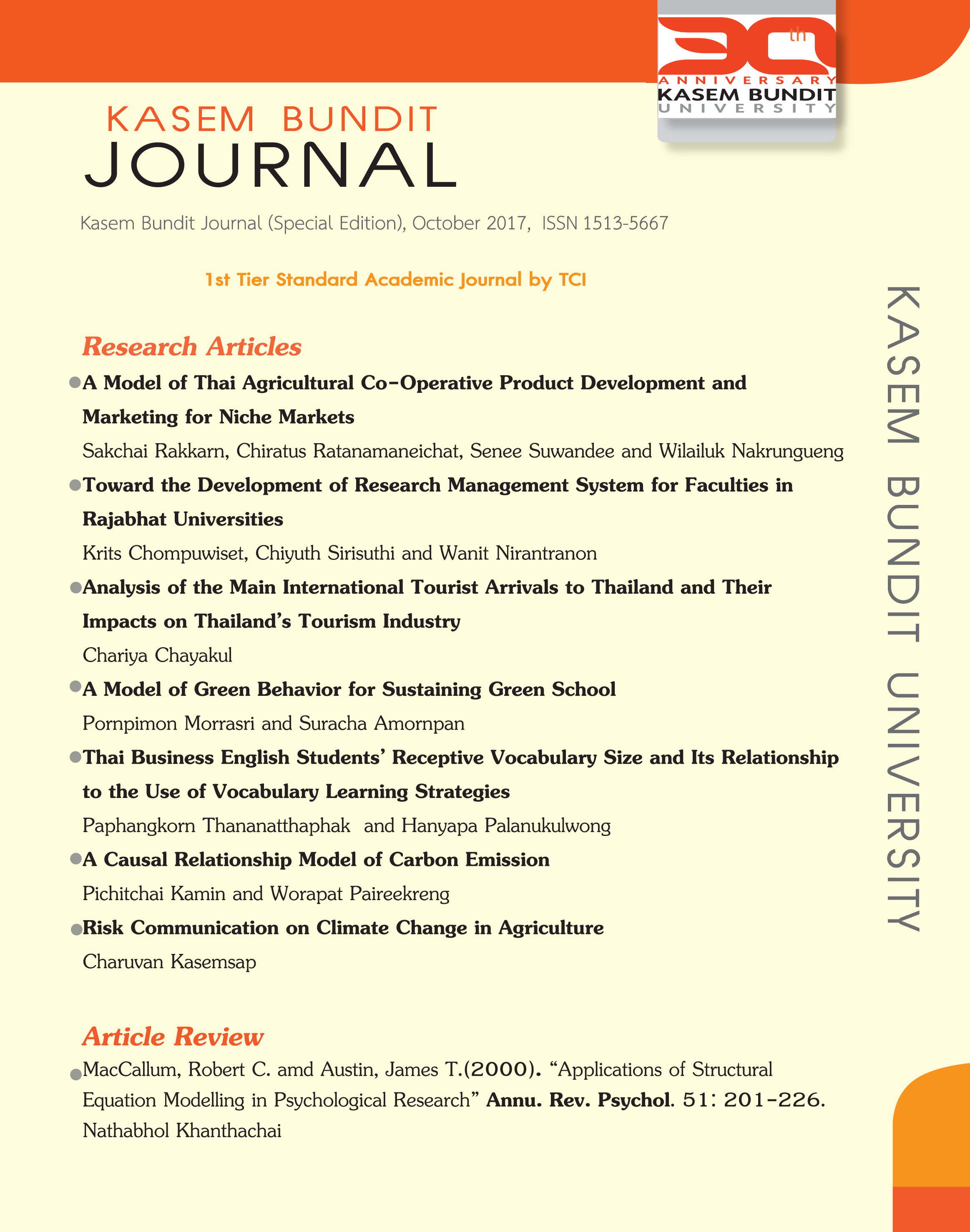Thai Business English Students’ Receptive Vocabulary Size and Its Relationship to the Use of Vocabulary Learning Strategies
Keywords:
Receptive vocabulary size, Vocabulary learning strategies, Thai business English studentsAbstract
This research investigated business English students’ receptive vocabulary size and their use of vocabulary learning strategies. The study also aimed to examine the relationship between the students’ receptive vocabulary size and their vocabulary learning strategies. The units of analysis were 59 second-year business English students who were attending a university in Trang Province, Thailand. Two research instruments were utilized i.e. an English-Thai receptive vocabulary size test and a questionnaire regarding vocabulary learning strategies. Findings revealed that the students’ average receptive vocabulary size was approximately 4,897 words, which was insufficient for effective listening. The students used the vocabulary learning strategies at a moderate level. Determination strategies were the type most frequently employed by the students. Furthermore, 11 out of 39 vocabulary learning strategies were highly employed by them to acquire vocabulary. The achievers with a high vocabulary size employed two strategies contributing to their receptive vocabulary size while their counterparts with a low vocabulary size used only one such strategy. The students’ receptive vocabulary size was positively and significantly (p<0.05) correlated with vocabulary learning strategies (rs=.241-.470).
References
Cameron, L. (2001). Teaching languages to young learner. Cambridge: Cambridge University Press.
Crystal, D.(2003). English as a Global Language. Cambridge:Cambridge University Press: Cambridge.
Cunningsworth, A. (1995). Choosing your Course Book. Oxford: Heinemann.
Fan, M. (2003). Frequency of Use, Perceived Usefulness and Actual Usefulness of Second Language Vocabulary Strategies: A study of Hong Kong learners. The Modern Language Journal, 87(2), 222-241.
Gu, Y. and Johnson, R.K. (1996). Vocabulary learning strategies and language learning
Outcomes. Language Learning, 46 (4), 643-679.
Hamzah et al., 2009 Hamzah, M.S. G., Kafipour, R., & Abdullah, S.K. (2009). Vocabulary learning strategies of Iranian undergraduate EFL students and its relation to their vocabulary size. European Journal of Social Sciences, 11(1), 39-50.
Kalajahi, S. & Pourshahian, B. (2012). Vocabulary learning strategies and vocabulary size of
ELT students at EMU in Northern Cyprus. English Language Teaching, 5(4), 138-149.
Komol, T. and Sripetpun, W. (2011). Vocabulary Learning Strategies Employed by Undergraduate Students and Its Relationship to their vocabulary Knowledge. Paper Presented at the 3th International Conference on Humanities and Social Science, 1-18.
MecCarty, F. (2000). Lexical and grammatical knowledge in reading and listening comprehension by foreign language learners of Spanish. Applied Language Learning, 11(2), 323-348.
Nation, P. (1990). Teaching and Learning Vocabulary. New York: Heinle and Heinle.
----------.(2001). Learning Vocabulary in Another Language. Cambridge: Cambridge
University Press.
----------. (2005). Teaching vocabulary. Asian EFL Journal.
Nation, P. (2006). How Large a Vocabulary is Needed for Reading and Listening? Canadian Modern Language Review, 63(1), 59-82.
Nation, P. and Beglar, D. (2007). A vocabulary size test. The Language Teacher, 31(7), 9-13.
Nirattisai, S. and Chiramanee, T. (2014). Vocabulary Learning Strategies of Thai University Students and Its Relationship to vocabulary Size. International Journal of English Language Education. 2(1), 273-287.
Nunan, D., & Miller, L. (eds.), (1995). New ways in teaching listening. Washington DC: TESOL.
Scharle, Á., and Szabó, A. (2000). Learner autonomy: A guide to developing learner responsibility. Cambridge: Cambridge University Press.
Schmitt, N. (2010). Researching vocabulary: A vocabulary research manual. Basingstoke: PalgraveMacmillan.
Schmitt, N. and Mccarthy, M. (1997). Vocabulary descriptive, acquisition and pedagogy. Cambridge University Press.
Sokmen, A. (1997). Current trends in teaching second language vocabulary.In N. Schmitt & M.
Downloads
Published
How to Cite
Issue
Section
License
ทัศนคติ ความคิดเห็นใด ๆ ที่ปรากฏในวารสารเกษมบัณฑิตฉบับนี้เป็นของผู้เขียน โดยเฉพาะ มหาวิทยาลัยเกษมบัณฑิตและบรรณาธิการ ไม่จำเป็นต้องมีความเห็นพ้องด้วย







